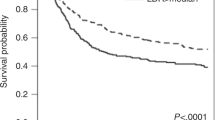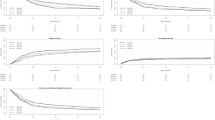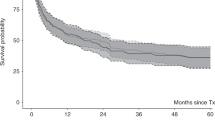Abstract
Allogeneic hematopoietic stem cell transplantation (allo-SCT) may offer a cure for selected patients with multiple myeloma (MM). Effective prognostic markers to guide patient selection are warranted. We retrospectively studied a cohort of 100 relapsed refractory MM patients who underwent allo-SCT. With a median follow-up of 12.2 years, median overall survival (OS) and progression-free survival (LFS) were 9.2 months and 5.6 months, respectively. 5-years OS and PFS were was 18.0% and 16.8%. The cumulative incidence of 5-years relapse was 45.9% and non-relapse mortality (NRM) 36.0%. In a multivariable Cox model, decreasing albumin, increasing lactate dehydrogenase (LDH), advanced disease, and mismatched donors were predictive of both reduced OS and PFS. The probability of 5-years OS was higher in patients with LDH below vs. the upper limit of normal (22% vs. 5%, p = 0.004). In the multivariable analysis, the hazard of NRM was increased with low albumin, mismatched donor type, and declining estimated glomerular filtration rate (eGFR). Patients with a low eGFR had a 5-year NRM incidence of 31% vs. 56% in patients with higher levels (p = 0.02). Graft-versus-host disease was not associated with improved outcomes. In conclusion, LDH, renal function, and albumin are highly informative of outcomes in MM patients treated with allo-SCT.
This is a preview of subscription content, access via your institution
Access options
Subscribe to this journal
Receive 12 print issues and online access
$259.00 per year
only $21.58 per issue
Buy this article
- Purchase on SpringerLink
- Instant access to full article PDF
Prices may be subject to local taxes which are calculated during checkout

Similar content being viewed by others
Change history
12 March 2020
Following publication, the authors noticed an error in the title of this article. The word “transplantation” was missed off the end of the title. The title has now been corrected to “LDH and renal function are prognostic factors for long-term outcomes of multiple myeloma patients undergoing allogeneic hematopoietic stem cell transplantation” in both the PDF and HTML versions of this article.
References
Kumar SK, Rajkumar SV, Dispenzieri A, Lacy MQ, Hayman SR, Buadi FK, et al. Improved survival in multiple myeloma and the impact of novel therapies. Blood. 2008;111:2516–20. https://doi.org/10.1182/blood-2007-10-116129.
Anderson KC. Progress and paradigms in multiple myeloma. Clin Cancer Res. 2016;22:5419–27. https://doi.org/10.1158/1078-0432.CCR-16-0625.
Miething CC. Clonal evolution in myeloma: a narrow road to remission. Haematologica. 2019;104:1292–3. https://doi.org/10.3324/haematol.2019.220152.
Gratwohl A, Baldomero H, Passweg J, Frassoni F, Niederwieser D, Schmitz N, et al. Hematopoietic stem cell transplantation for hematological malignancies in Europe. Leukemia. 2003;17:941–59. https://doi.org/10.1038/sj.leu.2402896.
Pidala J, Anasetti C, Jim H. Quality of life after allogeneic hematopoietic cell transplantation. Blood. 2009;114:7–19. https://doi.org/10.1182/blood-2008-10-182592.
Gonsalves WI, Buadi FK, Ailawadhi S, Bergsagel PL, Chanan Khan AA, Dingli D, et al. Utilization of hematopoietic stem cell transplantation for the treatment of multiple myeloma: a Mayo Stratification of Myeloma and Risk-Adapted Therapy (mSMART) consensus statement. Bone Marrow Transpl. 2019;54:353–67. https://doi.org/10.1038/s41409-018-0264-8.
Gahrton G, Svensson H, Cavo M, Apperly J, Bacigalupo A, Bjorkstrand B, et al. Progress in allogenic bone marrow and peripheral blood stem cell transplantation for multiple myeloma: a comparison between transplants performed 1983-93 and 1994-8 at European Group for Blood and Marrow Transplantation centres. Br J Haematol. 2001;113:209–16.
Bensinger WI, Buckner CD, Anasetti C, Clift R, Storb R, Barnett T, et al. Allogeneic marrow transplantation for multiple myeloma: an analysis of risk factors on outcome. Blood. 1996;88:2787–93.
Gahrton G, Tura S, Ljungman P, Blade J, Brandt L, Cavo M, et al. Prognostic factors in allogeneic bone marrow transplantation for multiple myeloma. J Clin Oncol. 1995;13:1312–22. https://doi.org/10.1200/JCO.1995.13.6.1312.
Maymani H, Lin P, Saliba RM, Popat U, Bashir Q, Shah N, et al. Comparison of outcomes of allogeneic hematopoietic cell transplantation for multiple myeloma using three different conditioning regimens. Biol Blood Marrow Transpl. 2019. https://doi.org/10.1016/j.bbmt.2019.01.009.
Greil C, Engelhardt M, Ihorst G, Schoeller K, Bertz H, Marks R, et al. Allogeneic transplantation of multiple myeloma patients may allow long-term survival in carefully selected patients with acceptable toxicity and preserved quality of life. Haematologica. 2019;104:370–9. https://doi.org/10.3324/haematol.2018.200881.
Maffini E, Storer BE, Sandmaier BM, Bruno B, Sahebi F, Shizuru JA, et al. Long-term follow up of tandem autologous-allogeneic hematopoietic cell transplantation for multiple myeloma. Haematologica. 2019;104:380–91. https://doi.org/10.3324/haematol.2018.200253.
Shimoni A, Hardan I, Ayuk F, Schilling G, Atanackovic D, Zeller W, et al. Allogenic hematopoietic stem-cell transplantation with reduced-intensity conditioning in patients with refractory and recurrent multiple myeloma: long-term follow-up. Cancer. 2010;116:3621–30. https://doi.org/10.1002/cncr.25228.
Bacigalupo A, Ballen K, Rizzo D, Giralt S, Lazarus H, Ho V, et al. Defining the intensity of conditioning regimens: working definitions. Biol Blood Marrow Transpl. 2009;15:1628–33. https://doi.org/10.1016/j.bbmt.2009.07.004.
Levey AS, Stevens LA, Schmid CH, Zhang YL, Castro AF III, Feldman HI, et al. A new equation to estimate glomerular filtration rate. Ann Intern Med. 2009;150:604–12.
Przepiorka D, Weisdorf D, Martin P, Klingemann HG, Beatty P, Hows J, et al. 1994 Consensus Conference on Acute GVHD Grading. Bone Marrow Transpl. 1995;15:825–8.
Filipovich AH, Weisdorf D, Pavletic S, Socie G, Wingard JR, Lee SJ, et al. National Institutes of Health consensus development project on criteria for clinical trials in chronic graft-versus-host disease: I. Diagnosis and staging working group report. Biol Blood Marrow Transpl. 2005;11:945–56. https://doi.org/10.1016/j.bbmt.2005.09.004.
Kumar S, Paiva B, Anderson KC, Durie B, Landgren O, Moreau P, et al. International Myeloma Working Group consensus criteria for response and minimal residual disease assessment in multiple myeloma. Lancet Oncol. 2016;17:e328–46. https://doi.org/10.1016/S1470-2045(16)30206-6.
Heinzl H, Kaider A. Gaining more flexibility in Cox proportional hazards regression models with cubic spline functions. Computer Methods Prog Biomed. 1997;54:201–8.
Carreras E, Dufour C, Mohty M, Kröger N. The EBMT handbook: hematopoietic stem cell transplantation and cellular Therapies. Springer; 2019.
Barlogie B, Kyle RA, Anderson KC, Greipp PR, Lazarus HM, Hurd DD, et al. Standard chemotherapy compared with high-dose chemoradiotherapy for multiple myeloma: final results of phase III US Intergroup Trial S9321. J Clin Oncol. 2006;24:929–36. https://doi.org/10.1200/JCO.2005.04.5807.
Rosinol L, Perez-Simon JA, Sureda A, de la Rubia J, de Arriba F, Lahuerta JJ, et al. A prospective PETHEMA study of tandem autologous transplantation versus autograft followed by reduced-intensity conditioning allogeneic transplantation in newly diagnosed multiple myeloma. Blood. 2008;112:3591–3. https://doi.org/10.1182/blood-2008-02-141598.
Lopez-Corral L, Caballero-Velazquez T, Lopez-Godino O, Rosinol L, Perez-Vicente S, Fernandez-Aviles F, et al. Response to novel drugs before and after allogeneic stem cell transplantation in patients with relapsed multiple myeloma. Biol Blood Marrow Transpl. 2019. https://doi.org/10.1016/j.bbmt.2019.04.026.
Sobh M, Michallet M, Gahrton G, Iacobelli S, van Biezen A, Schonland S, et al. Allogeneic hematopoietic cell transplantation for multiple myeloma in Europe: trends and outcomes over 25 years. A study by the EBMT Chronic Malignancies Working Party. Leukemia. 2016;30:2047–54. https://doi.org/10.1038/leu.2016.101.
Björkstrand B, Iacobelli S, Hegenbart U, Gruber A, Greinix H, Volin L, et al. Tandem autologous/reduced-intensity conditioning allogeneic stem-cell transplantation versus autologous transplantation in myeloma: long-term follow-up. J Clin Oncol. 2011;29:3016–22. https://doi.org/10.1200/JCO.2010.32.7312.
Lokhorst HM, van der Holt B, Cornelissen JJ, Kersten MJ, van Oers M, Raymakers R, et al. Donor versus no-donor comparison of newly diagnosed myeloma patients included in the HOVON-50 multiple myeloma study. Blood. 2012;119:6219–25. https://doi.org/10.1182/blood-2011-11-393801.
Kroger N, Einsele H, Derigs G, Wandt H, Krull A, Zander A. Long-term follow-up of an intensified myeloablative conditioning regimen with in vivo T cell depletion followed by allografting in patients with advanced multiple myeloma. Biol Blood Marrow Transpl. 2010;16:861–4. https://doi.org/10.1016/j.bbmt.2010.01.018.
Moreau P, Attal M, Hulin C, Arnulf B, Belhadj K, Benboubker L, et al. Bortezomib, thalidomide, and dexamethasone with or without daratumumab before and after autologous stem-cell transplantation for newly diagnosed multiple myeloma (CASSIOPEIA): a randomised, open-label, phase 3 study. Lancet. 2019;394:29–38. https://doi.org/10.1016/S0140-6736(19)31240-1.
Corradini P, Cavo M, Lokhorst H, Martinelli G, Terragna C, Majolino I, et al. Molecular remission after myeloablative allogeneic stem cell transplantation predicts a better relapse-free survival in patients with multiple myeloma. Blood. 2003;102:1927–9. https://doi.org/10.1182/blood-2003-01-0189.
Schilling G, Hansen T, Shimoni A, Zabelina T, Perez-Simon JA, Gutierrez NC, et al. Impact of genetic abnormalities on survival after allogeneic hematopoietic stem cell transplantation in multiple myeloma. Leukemia. 2008;22:1250–5. https://doi.org/10.1038/leu.2008.88.
Palumbo A, Avet-Loiseau H, Oliva S, Lokhorst HM, Goldschmidt H, Rosinol L, et al. Revised international staging system for multiple myeloma: a report from International Myeloma Working Group. J Clin Oncol. 2015;33:2863–9. https://doi.org/10.1200/JCO.2015.61.2267.
Gyurkocza B, Sandmaier BM. Conditioning regimens for hematopoietic cell transplantation: one size does not fit all. Blood. 2014;124:344–53. https://doi.org/10.1182/blood-2014-02-514778.
Shouval R, de Jong CN, Fein J, Broers AEC, Danylesko I, Shimoni A, et al. Baseline renal function and albumin are powerful predictors for allogeneic transplantation-related mortality. Biol Blood Marrow Transpl. 2018;24:1685–91. https://doi.org/10.1016/j.bbmt.2018.05.005.
Kroger N, Shimoni A, Schilling G, Schwerdtfeger R, Bornhauser M, Nagler A, et al. Unrelated stem cell transplantation after reduced intensity conditioning for patients with multiple myeloma relapsing after autologous transplantation. Br J Haematol. 2010;148:323–31. https://doi.org/10.1111/j.1365-2141.2009.07984.x.
Kroger N, Sayer HG, Schwerdtfeger R, Kiehl M, Nagler A, Renges H, et al. Unrelated stem cell transplantation in multiple myeloma after a reduced-intensity conditioning with pretransplantation antithymocyte globulin is highly effective with low transplantation-related mortality. Blood. 2002;100:3919–24. https://doi.org/10.1182/blood-2002-04-1150.
Rosinol L, Jimenez R, Rovira M, Martinez C, Fernandez-Aviles F, Marin P, et al. Allogeneic hematopoietic SCT in multiple myeloma: long-term results from a single institution. Bone Marrow Transpl. 2015;50:658–62. https://doi.org/10.1038/bmt.2014.320.
Crawley C, Lalancette M, Szydlo R, Gilleece M, Peggs K, Mackinnon S, et al. Outcomes for reduced-intensity allogeneic transplantation for multiple myeloma: an analysis of prognostic factors from the Chronic Leukaemia Working Party of the EBMT. Blood. 2005;105:4532–9. https://doi.org/10.1182/blood-2004-06-2387.
Acknowledgements
The study was supported by the Varda and Boaz Dotan Research Center in Hemato-oncology, Idea Award Research Grant, Tel-Aviv University.
Author information
Authors and Affiliations
Corresponding author
Ethics declarations
Conflict of interest
The authors declare that they have no conflict of interest.
Additional information
Publisher’s note Springer Nature remains neutral with regard to jurisdictional claims in published maps and institutional affiliations.
Supplementary information
Rights and permissions
About this article
Cite this article
Shouval, R., Teper, O., Fein, J.A. et al. LDH and renal function are prognostic factors for long-term outcomes of multiple myeloma patients undergoing allogeneic hematopoietic stem cell transplantation. Bone Marrow Transplant 55, 1736–1743 (2020). https://doi.org/10.1038/s41409-020-0829-1
Received:
Revised:
Accepted:
Published:
Issue date:
DOI: https://doi.org/10.1038/s41409-020-0829-1
This article is cited by
-
MicroRNA-125b as a valuable predictive marker for outcome after autologous hematopoietic stem cell transplantation
BMC Cancer (2023)
-
Correlations between apparent diffusion coefficient values of WB-DWI and clinical parameters in multiple myeloma
BMC Medical Imaging (2021)
-
High lactate dehydrogenase at time of admission for allogeneic hematopoietic transplantation associates to poor survival in acute myeloid leukemia and non-Hodgkin lymphoma
Bone Marrow Transplantation (2021)



